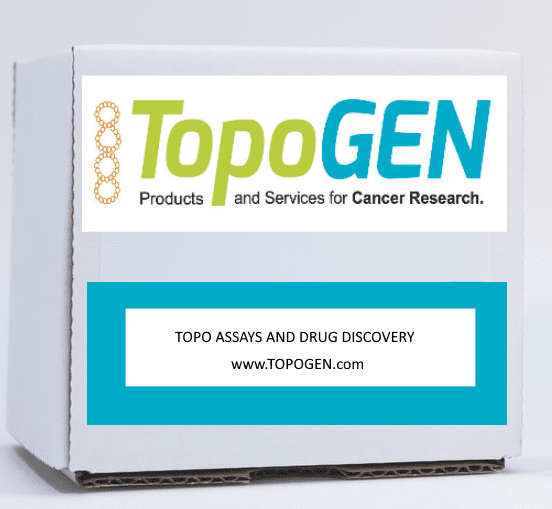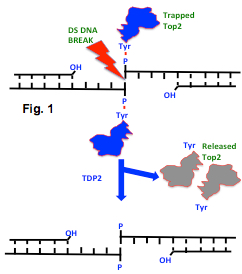Tyrosyl-DNA phosphodiesterase-2 (TDP2) functions to remove trapped topoisomerase II/DNA complexes by processing 5′- blocking protein (topo II) at the site of the DNA break (Fig 1). In terms of physiological relevance, there appear to be multiple roles for TDP2, well beyond the repair of type II topoisomerase damage and subsequent DNA repair. This is quite different from the Top1/DNA repair protein, TDP1. There are a number of mechanistic differences between TDP1 and 2 as well (see reviews from Pommier, PMID 24856239). In humans, TDP2 should be considered a multi-functional enzyme with roles in TNF and MAPK/JNK/p38 pathways. There is some similarity with APE1 and the superfamily of Mg++/Mn++ dependent phosphodiesterases and there is evidence that picorna viruses pirate TDP2 as a VPg un-linkase function. Given the key role for topo II in anticancer therapy, drugs that inhibit TDP2 might prove useful in combination therapy with established Interfacial Poisons (IFP) such as doxorubicin and etoposide (VP16). As a result of this thinking, there have been a few TDP2 candidate inhibitors. TDP2 specifically recognizes 5’-phosphotyrosyl bonds and synthetic substrates have been useful for HTS and drug discovery (example, 4-nitrophehyl phenylphosonate or radioactively tagged oligos). While these synthetic or semi-synthetic substrates are useful for high throughput screening, inhibitors need to be tested and validated on bona fide Top2/DNA covalent adducts. For this reason, TopoGEN has developed a true Top2/DNA substrate. We provide trapped, unprocessed Top2/kDNA covalent complexes that can be effectively used as TDP2 substrates (see Fig. 2 for the assay outline). Due to the presence of a covalently bound protein, the linear CC complexes cannot be detected (Fig. 2, left lane) unless either proteinase K is added (to degrade and release the bulk of the denatured Top2a) or TDP2 is reacted to release the trapped protein.
The Human TDP2 Assay Kit contains reagents necessary to quantify TDP2 activity in easy to prepare 1% agarose gels. Since kDNA is such a large substrate, the gels can be run quickly, (<10 min at 100-250v) thereby improving throughput. Markers are included to allow unambiguous interpretation of the results. By scanning the gels using shareware such as ImageJ, the results can easily be quantified.
The kit may be shipped at ambient temperature or on ice (dry ice or wet ice). The DNA should be stored at 4°C and the buffers store at -20°C upon receipt. Avoid frequent freeze/thaw cycles with the plasmid as this may contribute to DNA breakage.



